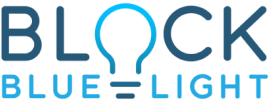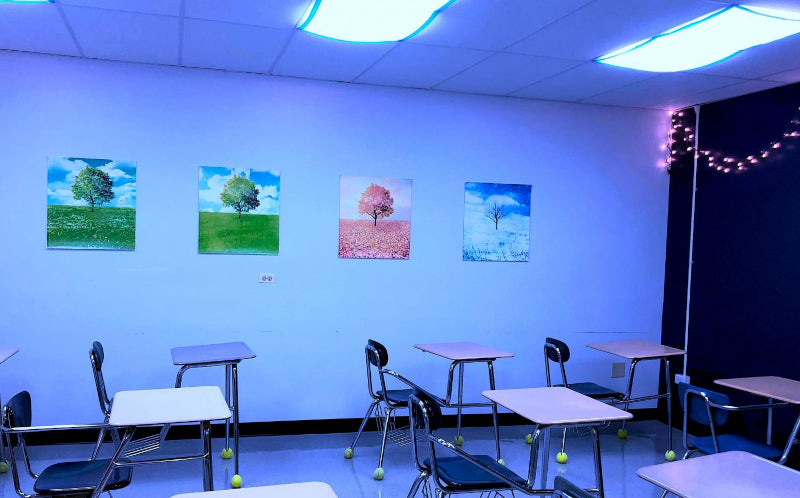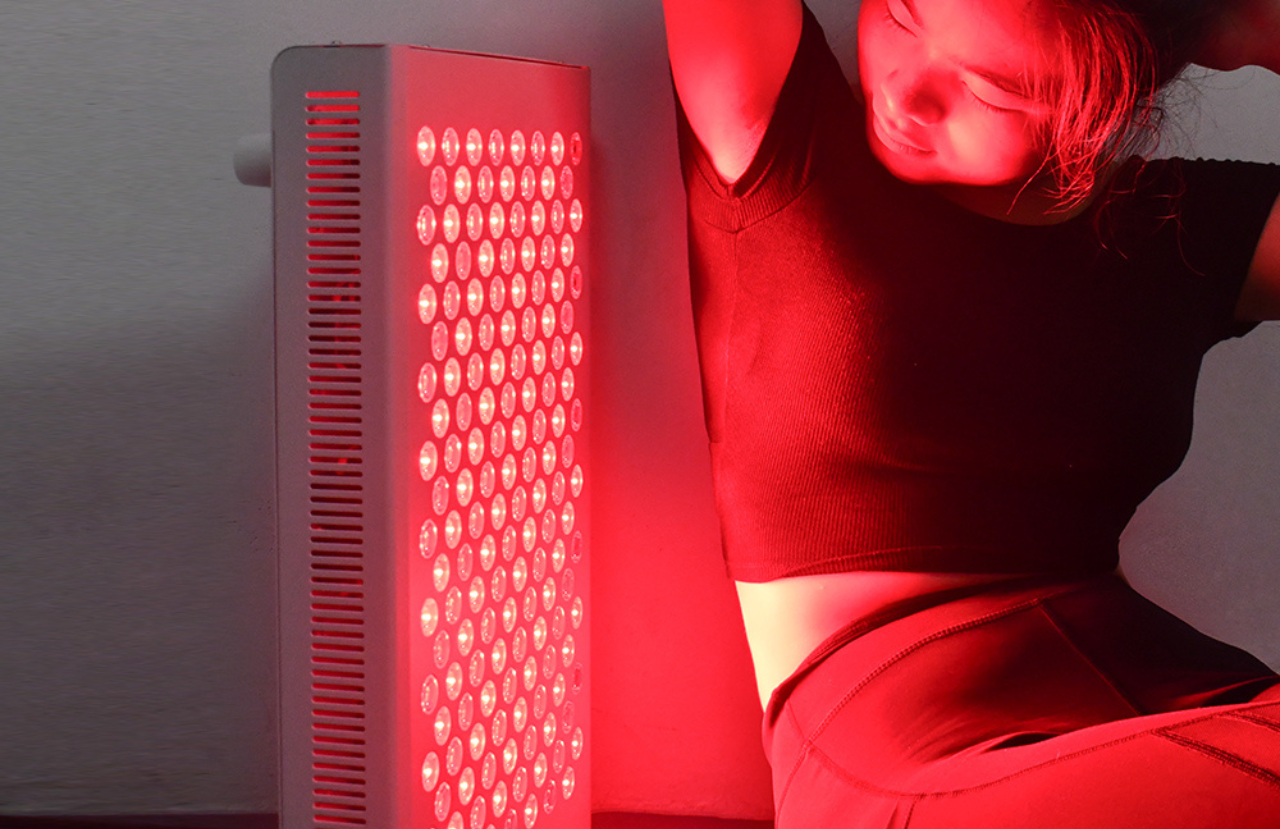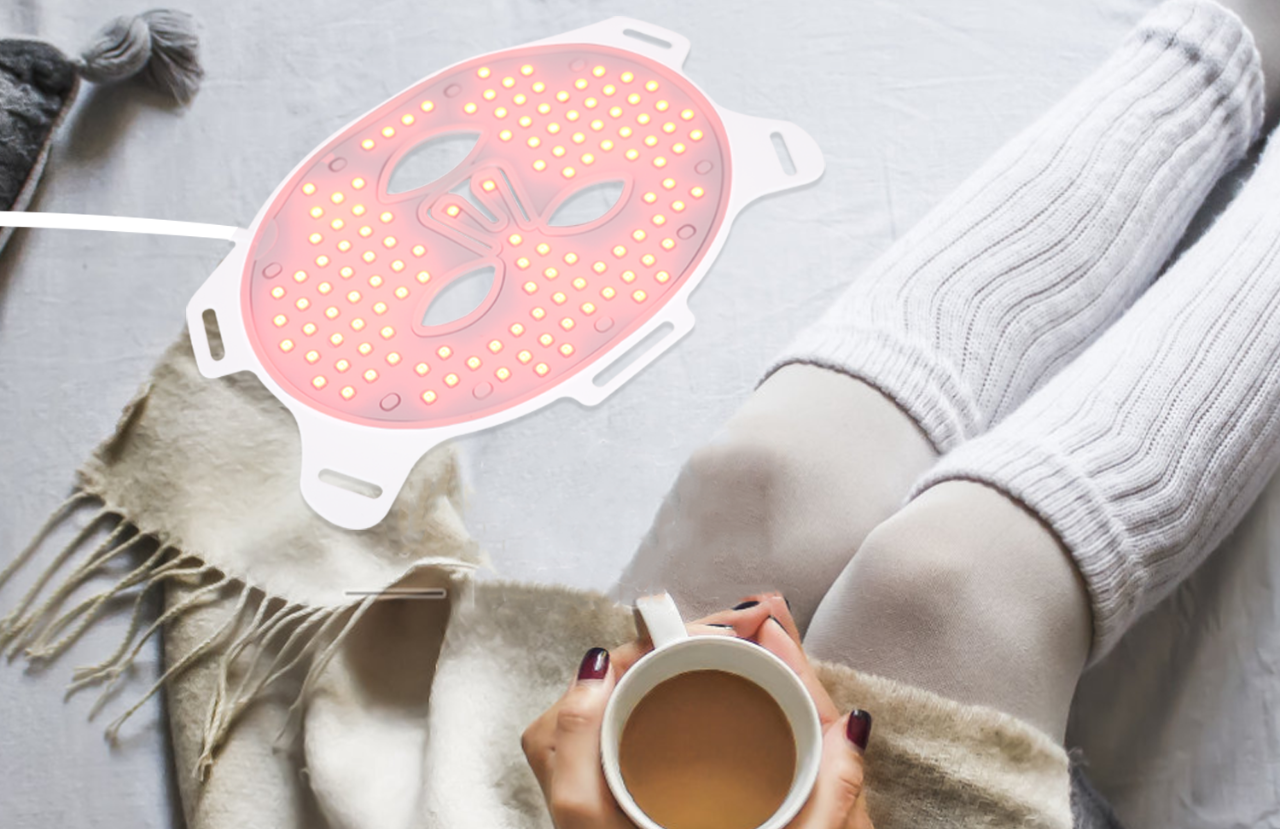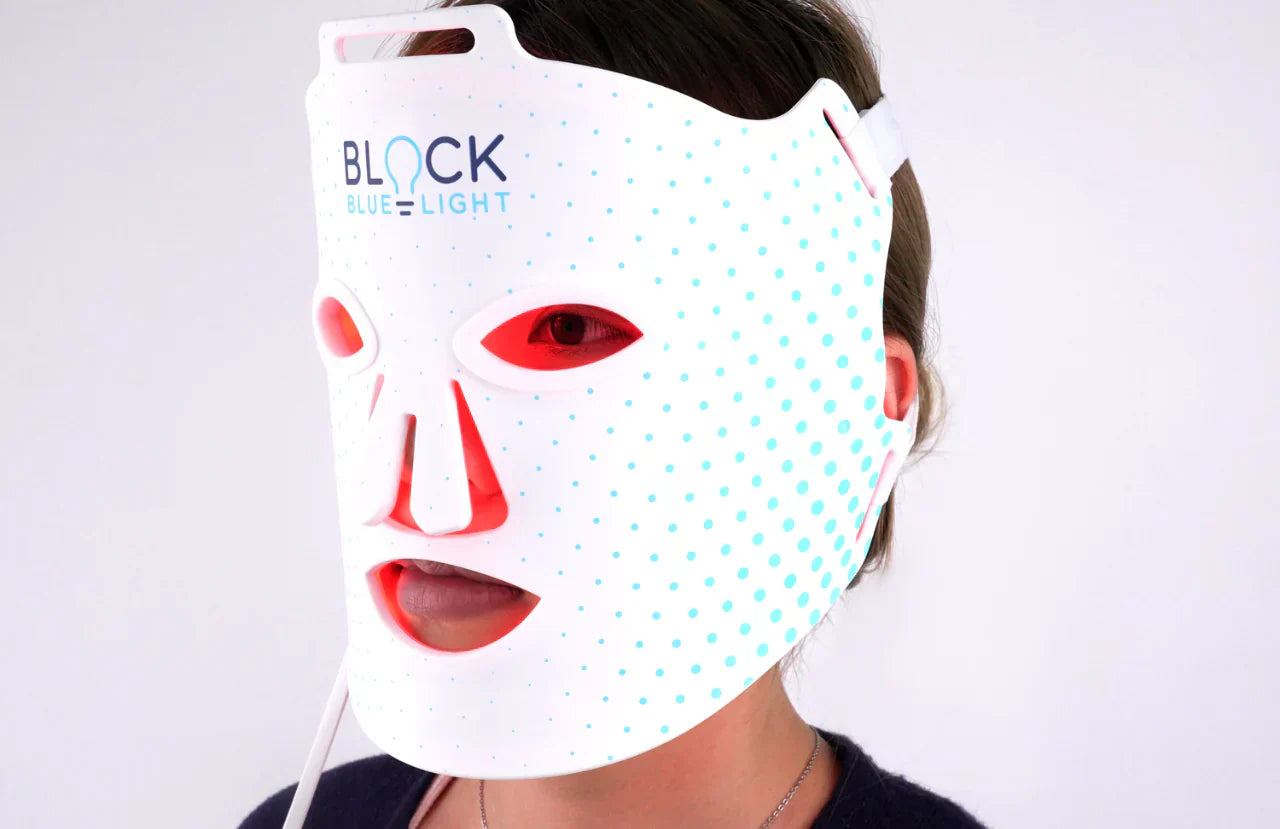Modern learning and education are increasingly reliant on electronic devices. From interactive flat panels, to tablets and laptop computers, students are spending increasing amounts of time being exposed to devices which are strong sources of blue light. Although beneficial in its naturally occurring state, blue light can also have a significant and negative impact on students’ eyes, as well as their mental and physical health.
What Is Blue Light?

Light consists of different colors. Each color has a slightly different effect, particularly on the human body. Blue light is perceived as being blue in color and occurs naturally. It is also present in what we perceive to be white light.
Blue light is made up of short, high-energy visible (HEV) wavelengths. The shorter rays found in blue light flicker more frequently than UV rays. As a result, they can cause a glare, which reduces sharpness, as well as visual contrast. When blue light is absorbed at high doses, it has the potential to cause more significant damage to the cells in our bodies.
The Benefits Of Blue Light
In small doses and at appropriate times of the day, blue light can offer a range of benefits. It plays an important role in regulating our natural wake and sleep cycles (the body’s circadian rhythm). When we are exposed to it during daylight hours, it can help to increase attention and alertness. Similarly, it can also help to regulate and increase energy levels, memory and improve and promote positive moods.
This offers some potential benefits when considering educational facility designs and the use of technology to promote learning. Increasing the amount of exposure to natural light sources in the mornings has been suggested to help strengthen and promote the body’s natural circadian cycle. As such, students are more likely to focus better on their learning and retain greater amounts of information.
This can be achieved within educational facilities, including classrooms, by keeping school windows clear and open during the mornings and installing skylights. Not only will this promote concentration and alertness, but it has also been found to help create a more positive atmosphere and mood in classrooms, which is conducive to learning.
The Hazards Of Blue Light
Whilst small doses of blue light can offer some benefits, the hazards are numerous. In particular, the negative impact of prolonged exposure to blue light, especially in children, is a growing concern for many researchers and educators.
Given that blue light contains shorter rays, these HEV rays are in fact able to penetrate more deeply into the eye than UV rays do. As such, prolonged exposure to blue light sources has been linked to increased macular degeneration, as well as to retinal damage. According to a study, which was published by the National Environmental Health Sciences peer-reviewed journal, there are even some findings which suggest that exposure to blue light can also lead to an increased risk of cancer. Furthermore, there is additional research which further suggests that blue light exposure can contribute to increased risk of diabetes, obesity and heart disease. Prolonged exposure to blue light has also been found to lead to increased headaches and migraines, as well as physical and mental fatigue and eye strain.
The Impact Of Blue Light Upon Sleep

Perhaps the biggest hazard associated with blue light is a significant disruption to sleep. Exposure to blue light in the afternoon and evenings, particularly in the two to three hours prior to bedtime, has been shown to significantly and negatively impact upon a person’s circadian rhythm. This disruption has negative consequences, including difficulty getting to sleep and subsequently, getting sufficient sleep, which is especially important for children and their learning.
Dr. Charles A Czeisler at Harvard Medical School conducted research into sleep disruption resulting from exposure to blue light (such as that found in electronic devices, including tablets, smartphones and LED lightbulbs) in the late afternoon and evening. The findings concluded that sleep cycles were disrupted by six to eight hours. This was a similar amount to that which you might expect to experience from jet lag after a flight from New York City to Honolulu.
During daylight hours, there are increased levels of blue light. This short-wavelength light plays an important role in regulating alertness because it increases the levels of cortisol in the brain. As daylight fades, so too does the amount of blue light to which the body is exposed. Instead, the body becomes increasingly exposed to longer- wavelengths, such as those found in redder colors. This reduction in blue-light exposure helps to signal to the hypothalamus that it is time to begin to suppress the cortisol levels and instead to increase the release of melatonin. Melatonin is important because it is a chemical which promotes sleep.
However, by continuing to expose the body to blue light sources into the evening or the hours preceding bedtime, the release of melatonin is delayed. This delay can have a detrimental effect on sleep, making it increasingly harder to fall asleep, which can lead to poor quality and insufficient sleep. Lack of sleep itself can then cause students to feel more tired during the day and reduce their ability to remain alert, focused and to embed their learning and commit it to memory effectively.
Sources Of Blue Light In Schools
A source of blue light increasingly found in classrooms comes from light emitting diodes (LEDs). Most LEDs are often perceived as white light. However, many LEDs actually emit greater amounts of blue light than many other traditional sources of light.
LED bulbs are considered to be a better choice for the environment and as such are being increasingly used to provide indoor lighting, including in classrooms. Exposure to LED lighting in the afternoon or evening can significantly impact on the body’s natural circadian rhythm, delaying the release of melatonin by up to two hours.
Most of the modern electronic devices in use today, including those used by schools and colleges, rely on LED technology. The bright white light used to backlight the displays on devices such as smartphones, tablets, laptop computers and interactive whiteboards, is the result of LED technology and in fact, produces a large amount of blue light.

Most classrooms now utilize interactive flat panels (IFPs). In many cases, the use of such devices is seen as paramount to helping to promote engagement and success within classrooms. Similarly, there has also been an increase in the use of electronic devices and screens utilized within classrooms, including through increased use of computers, laptops and tablets. All of these devices are strong sources of blue light.
Furthermore, schools are encouraging the use of electronic devices at home. This also includes the rolling out of take-home devices, such as tablets or laptops to help support student achievement and learning. Equally significant is the increase in the amount of time spent staring at computer screens by students, resulting from the shift towards e-learning as a consequence of the coronavirus (COVID-19) pandemic.
Increased Exposure To Blue Light From Electronic Devices For Learning Purposes
The increased exposure to screens and electronic devices in the evening can make it harder for students to get to sleep and results in them being more tired for the following day. As students continue to complete their homework until late in the evenings, this can cause an unhealthy and harmful cycle to begin, which becomes difficult to address and break over time.
“Many researchers and teachers, consider that it’s increasingly important to educate parents and students alike on the appropriate use of electronic devices in the evenings. Contrary to the belief that spending more time studying in the evening will benefit students’ learning, the opposite is actually closer to the truth,” says Ruby Wheeler, an educator at LiaHelp and Big Assignments. “By staying up late to study, students delay the onset of sleep and the release of melatonin. As such, they reduce the number of hours they are sleeping. Research into sleep has found that even small deficits in the amount of sleep that students get, can in fact hinder their memory and ability to learn effectively.”
Additionally, lack of sleep has also been found to be linked to increased risks of obesity, depression and, perhaps unsurprisingly, increased likelihood of being involved in a car accident.
When considering the use of electronic devices for educational purposes at home, as part of online learning or within the classroom, it is important to understand the effects that prolonged exposure to such devices may be having on students and teachers, including their physical and mental wellbeing. Carefully considering the use of technology, including times of day when it is used, is essential if students’ learning is to be enhanced rather than hindered.
Similarly, researchers argue that it’s imperative that parents are properly educated on how to regulate the use of devices for educational purposes within their home. When distributing tablets or laptops for home use, researchers argue that parents should also be provided with some general training on how it should be used. This should include guidance on applying a limit or curfew on when devices are used, so as to help address the negative impact that the exposure to blue light can have on students’ sleep.
Reducing Hazards Of Blue Light In Classrooms
Educating students on the negative impact of prolonged exposure to blue light is important for helping them to understand the importance of reducing their exposure to blue light emitting sources in the evenings. Additionally, by educating them on these effects, students can then be better supported to develop healthy daily habits which will benefit their health, as well as support and enhance their learning.
Schools can reduce staff and students’ exposure to blue light by carefully considering and planning times for the use of technology. Where possible, prioritizing use of screen and electronic devices in the morning would allow for the blue light exposure to prove beneficial, rather than harmful. Similarly, schools should aim to increase their access to natural light, especially in the afternoons, so as to reduce the amount of artificial lighting being used. This will not only promote a more positive atmosphere, but will also stimulate the natural circadian rhythm and support teachers and students’ wellbeing and learning.
Schools can also ensure that the screens used in classrooms have appropriate filters and protection. The screen brightness levels on all devices should be appropriately adjusted and blue light filters should be available and applied, especially during evening use. IFPs should also be carefully chosen. Schools should opt for newer IFPs, particularly those flat panels which have been certified and undergone a Low Blue Light safety and performance test, which filters out and eliminates harmful blue light.
“As far as possible, students should be encouraged to avoid doing homework or studying at night. Instead, they should aim to turn off electronic devices one to two hours before bedtime to help stimulate the release of melatonin. If devices are still being used, then screen brightness should be adjusted accordingly and a blue light filter app should be applied, such as night mode. This will allow the warmer colors of the spectrum to be enabled and reduce the amount of blue light being emitted,” says James Glenn, a teacher at Boomessays and OXessays.
Conclusion
As technology continues to be increasingly used in both the physical classroom, as well as the digital classroom, it’s perhaps inevitable that students will also be increasingly exposed to blue light. However, through understanding of the impacts and benefits of blue light, schools have the possibility to adapt their classrooms to utilize technology to promote learning and reduce the risk to the health of staff and students.
As well as increasing exposure to natural sunlight, classrooms can also be fitted with appropriate screens which limit the amount of blue light exposure, as well as applying blue light filters on portable devices and educating students and parents on ways to limit screen times. In this way, technology can continue to be used to enhance learning opportunities, whilst protecting the health of staff and students alike.
And when other measures are not possible, our Kids ScreenTime Computer Glasses will filter 50% of 400 to 500 nanometer light, no matter what the source. Not only this – all our computer glasses also have the ability to block 455 nanometer blue light, the most harmful frequency. This is in stark contrast to most other clear blue blocking glasses on the market, which only manage to block around 15-20% of 400 to 430 nanometer blue light, and which do not block any 455 nanometer light at all!
